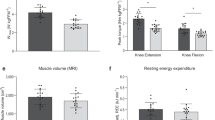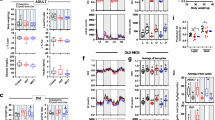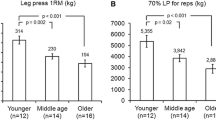Abstract
In humans, decreases in cardiac output play an important role in the age-related decrease in whole-body oxidative capacity. What remains less clear is whether a decline in skeletal muscle oxidative capacity is also an inevitable consequence of aging, as a number of other factors that could affect oxidative capacity also change with age, including: physical activity, health status, fibre-type composition, rates of protein synthesis and muscle blood supply. Both in vitro studies using muscle biopsy tissue and in vivo studies using 31P-magnetic resonance spectroscopy are used to study muscular oxidative capacity. Using these methodologies, researchers have found age-associated reductions in the oxidative capacities of specific muscles. In most cases, however, the influence of physical activity has not been adequately controlled, making it difficult to evaluate the effects of age itself from those of lifestyle changes associated with aging.
Upon critical evaluation of the existing literature, the following picture regarding the effect of age on muscle oxidative capacity appears: although the maximum level of muscular oxidative capacity attainable through training may decline with age, much of the age-associated decline in oxidative function is related to the reductions in fitness and/or habitual physical activity that typically occur in this population. Future studies in this area must account for the health and activity status of their study participants.


Similar content being viewed by others
References
Proctor DN, Joyner MJ. Skeletal muscle mass and the reduction of V̇O2max in trained older subjects. J Appl Physiol 1997; 82: 1411–5
Kent-Braun JA, Ng AV. Skeletal muscle oxidative capacity in young and older women and men. J Appl Physiol 2000; 89: 1072–8
Coggan AR, Abduljalil AM, Swanson SC, et al. Muscle metabolism during exercise in young and older untrained and endurance-trained men. J Appl Physiol 1993; 75: 2125–33
Coggan AR, Spina RJ, King DS, et al. Histochemical and enzymatic comparison of the gastrocnemius muscle of young and elderly men and women. J Gerontol 1992; 47: B71–6
Conley KE, Jubrias SA, Esselman PC. Oxidative capacity and ageing in human muscle. J Physiol 2000; 526 Pt 1: 203–10
McCully KK, Fielding RA, Evans WJ, et al. Relationships between in vivo and in vitro measurements of metabolism in young and old human calf muscles. J Appl Physiol 1993; 75: 813–9
Chilibeck PD, Paterson DH, McCreary CR, et al. The effects of age on kinetics of oxygen uptake and phosphocreatine in humans during exercise. Exp Physiol 1998; 83: 107–17
Schunk K, Pitton M, Duber C, et al. Dynamic phosphorus-31 magnetic resonance spectroscopy of the quadriceps muscle: effects of age and sex on spectroscopic results. Invest Radiol 1999; 34: 116–25
Elder GC, Bradbury K, Roberts R. Variability of fiber type distributions within human muscles. J Appl Physiol 1982; 53: 1473–80
Staron RS, Karapondo DL, Kraemer WJ, et al. Skeletal muscle adaptations during early phase of heavy-resistance training in men and women. J Appl Physiol 1994; 76: 1247–55
Houmard JA, Weidner ML, Gavigan KE, et al. Fiber type and citrate synthase activity in the human gastrocnemius and vastus lateralis with aging. J Appl Physiol 1998; 85: 1337–41
Pastoris O, Boschi F, Verri M, et al. The effects of aging on enzyme activities and metabolite concentrations in skeletal muscle from sedentary male and female subjects. Exp Gerontol 2000; 35: 95–104
Rooyackers OE, Adey DB, Ades PA, et al. Effect of age on in vivo rates of mitochondrial protein synthesis in human skeletal muscle. Proc Natl Acad Sci U S A 1996; 93: 15364–9
Proctor DN, Sinning WE, Walro JM, et al. Oxidative capacity of human muscle fiber types: effects of age and training status. J Appl Physiol 1995; 78: 2033–8
Meredith CN, Frontera WR, Fisher EC, et al. Peripheral effects of endurance training in young and older subjects. J Appl Physiol 1989; 66: 2844–9
Barrientos A, Casademont J, Rotig A, et al. Absence of relationship between the level of electron transport chain activities and aging in human skeletal muscle. Biochem Biophys Res Commun 1996; 229: 536–9
Brierley EJ, Johnson MA, James OF, et al. Effects of physical activity and age on mitochondrial function. Q J Med 1996; 89: 251–8
Farley CT, Ferris DP. Biomechanics of walking and running: center of mass movements to muscle action. Exerc Sport Sci Rev 1998; 26: 253–85
Henneman E, Somjen G, Carpenter DO. Functional significance of cell size in spinal motoneurons. J Neurophysiol 1965; 28: 560–80
Zajac FE, Faden JS. Relationship among recruitment order, axonal conduction velocity, and muscle-unit properties of type-identified motor units in cat plantaris muscle. J Neurophysiol 1985; 53: 1303–22
Rasmussen HN, Andersen AJ, Rasmussen UF. Optimization of preparation of mitochondria from 25–100mg skeletal muscle. Anal Biochem 1997; 252: 153–9
Short KR, Nair KS. Does aging adversely affect muscle mitochondrial function? Exerc Sport Sci Rev 2001; 29: 118–23
Welle S, Bhatt K, Shah B, et al. Reduced amount of mitochondrial DNA in aged human muscle. J Appl Physiol 2003; 94: 1479–84
Chance B, Eleff S, Leigh JSJ. Noninvasive, nondestructive approaches to cell bioenergetics. Proc Natl Acad Sci USA 1980; 77: 7430–4
Kent-Braun JA, Miller RG, Weiner MW. Human skeletal muscle metabolism in health and disease: utility of magnetic resonance spectyroscopy. Exerc Sport Sci Rev 1995; 23: 305–47
Sapega AA, Sokolow DP, Graham TJ, et al. Phosphorus nuclear magnetic resonance: a non-invasive technique for the study of muscle bioenergetics during exercise. Med Sci Sports Exerc 1987; 19: 410–20
Chilibeck PD, McCreary CR, Marsh GD, et al. Evaluation of muscle oxidative potential by 3 1P-MRS during incremental exercise in old and young humans. Eur J Appl Physiol 1998; 78: 460–5
McCully KK, Forciea MA, Hack LM, et al. Muscle metabolism in older subjects using P magnetic resonance spectroscopy. Can J Physiol Pharmacol 1991; 69: 576–80
Meyer RA. A linear model of muscle respiration explains monoexponential phosphocreatine changes. Am J Physiol 1988; 254: C548–53
Quistorff B, Johansen L, Sahlin K. Absence of phosphocreatine resynthesis in human muscle during ischaemic recovery. Biochem J 1992; 291: 681–6
Larson-Meyer DE, Newcomer BR, Hunter GR, et al. Relation between in vivo and in vitro measurements of skeletal muscle oxidative metabolism. Muscle Nerve 2001; 24: 1665–76
Arnold DL, Matthews PM, Radda GK. Metabolic recovery after exercise and the assessment of mitochondrial function in vivo in human skeletal muscle by means of 3 1P NMR. Magn Reson Med 1984; 1: 307–15
Kemp GJ, Radda GK. Quantitative interpretation of bioenergetic data from 31P and 1H magnetic resonance spectroscopic studies of skeletal muscle: an analytical review. Magn Reson Q 1994; 10: 43–63
Walter G, Vandenborne K, McCully KK, et al. Noninvasive measurement of phosphocreatine recovery kinetics in single human muscles. Am J Physiol 1997; 272: C525–34
Haseler LJ, Hogan MC, Richardson RS. Skeletal muscle phosphocreatine recovery in exercise-trained humans is dependent on O2 availability. J Appl Physiol 1999; 86: 2013–8
Chance B, Leigh JSJ, Clark BJ, et al. Control of oxidative metabolism and oxygen delivery in human skeletal muscle: a steady-state analysis of the work/energy cost transfer function. Proc Natl Acad Sci U S A 1985; 82: 8384–8
Kent-Braun JA, McCully KK, Chance B. Metabolic effects of training in humans: a 31P-MRS study. J Appl Physiol 1990; 69: 1165–70
Kent-Braun JA, Miller RG, Weiner MW. Phases of metabolism during progressive exercise to fatigue in human skeletal muscle. J Appl Physiol 1993; 75: 573–80
Marsh GD, Paterson DH, Thompson RT, et al. Metabolic adaptations to endurance training in older individuals. Can J Appl Physiol 1993; 18: 366–78
Jubrias SA, Esselman PC, Price LB, et al. Large energetic adaptations of elderly muscle to resistance and endurance training. J Appl Physiol 2001; 90: 1663–70
Kirkeby S, Garbarsch C. Aging affects different human muscles in various ways: an image analysis of the histomorphometric characteristics of fiber types in human masseter and vastus lateralis muscles from young adults and the very old. Histol Histopathol 2000; 15: 61–71
Klitgaard J, Zhou M, Schiaffino S, et al. Ageing alters the myosin heavy chain composition of single fibres from human skeletal muscle. Acta Physiol Scand 1990; 140: 55–62
Bottinelli R. Functional heterogeneity of mammalian single muscle fibres: do myosin isoforms tell the whole story? Pflugers Arch 2001; 443: 6–17
Gregory CM, Vandenborne K, Dudley GA. Metabolic enzymes and phenotypic expression among human locomotor muscles. Muscle Nerve 2001; 24: 387–93
Hook P, Sriramoju V, Larsson L. Effects of aging on actin sliding speed on myosin from single skeletal muscle cells of mice, rats, and humans. Am J Physiol Cell Physiol 2001; 280: C782–8
Larsson L, Li X, Frontera WR. Effects of aging on shortening velocity and myosin isoform composition in single human skeletal muscle cells. Am J Physiol 1997; 272: C638–49
Parizkova J, Eiselt E, Sprynarova S, et al. Body composition, aerobic capacity, and density of muscle capillaries in young and old men. J Appl Physiol 1971; 31: 323–5
Chilibeck PD, Paterson DH, Cunningham DA, et al. Muscle capillarization O2 diffusion distance, and V̇O2 kinetics in old and young individuals. J Appl Physiol 1997; 82: 63–9
Acknowledgements
This work was supported by NIH R01 AG21094. The authors have no conflicts of interest that are directly relevant to the content of this review.
Author information
Authors and Affiliations
Rights and permissions
About this article
Cite this article
Russ, D.W., Kent-Braun, J.A. Is Skeletal Muscle Oxidative Capacity Decreased in Old Age?. Sports Med 34, 221–229 (2004). https://doi.org/10.2165/00007256-200434040-00002
Published:
Issue Date:
DOI: https://doi.org/10.2165/00007256-200434040-00002




